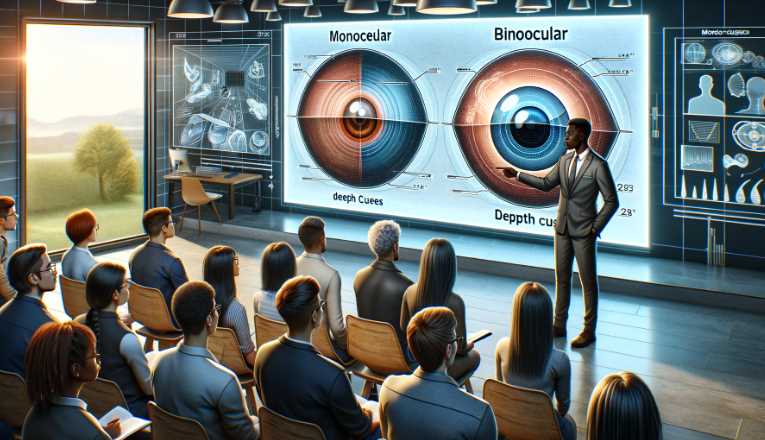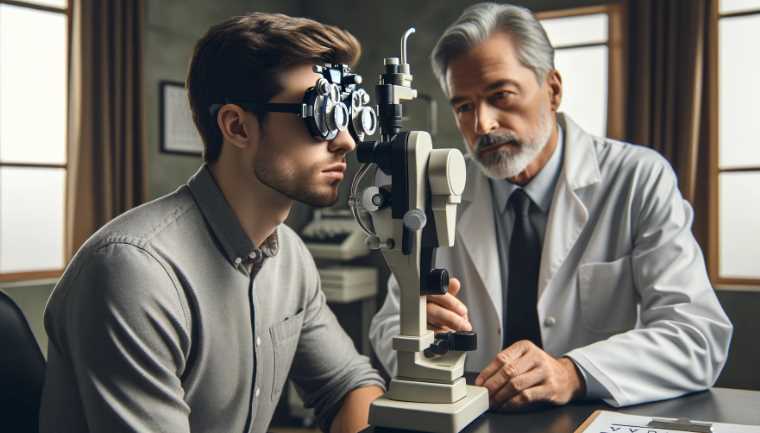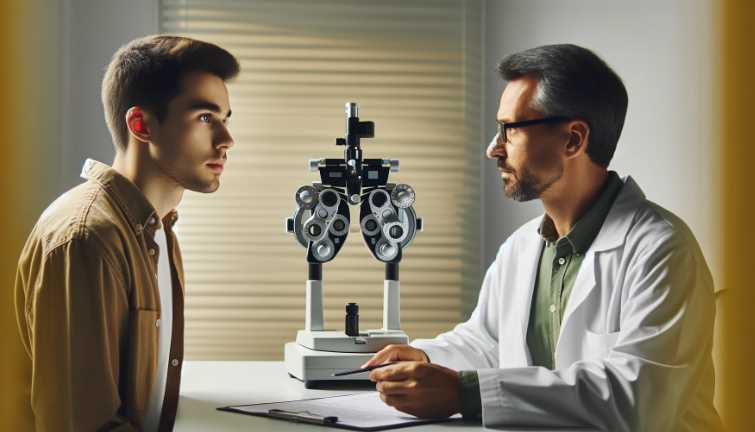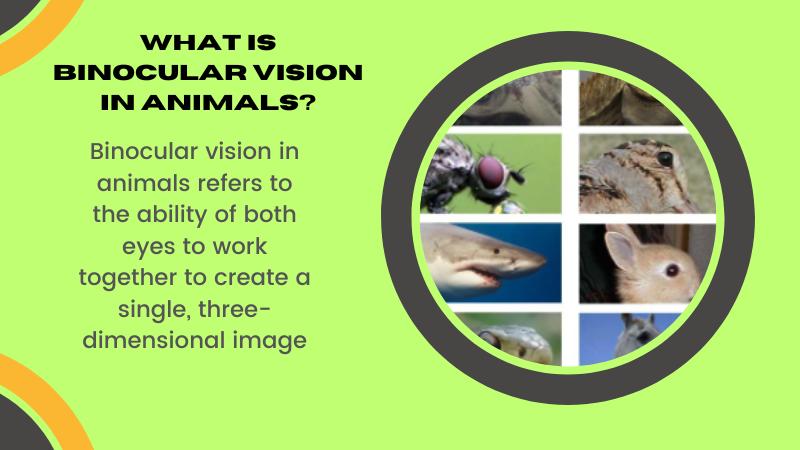Monocular depth cues rely on visual information available to one eye, while binocular depth cues involve the combined input from both eyes.
Monocular and binocular depth cues help the brain perceive the three-dimensional aspects of the visual world. These cues are essential for depth perception, which enables us to gauge distances and perceive the relative positions of objects in our environment.
| Image | Product | Detail | Price |
|---|---|---|---|
 | Carson MicroBrite Plus 60x-120x LED Lighted Pocket Microscope |
| See on Amazon |
 | Elikliv LCD Digital Coin Microscope |
| See on Amazon |
 | AmScope M150 Series Portable Compound Microscope |
| See on Amazon |
 | PalliPartners Compound Microscope for Adults & Kids |
| See on Amazon |
 | Skybasic 50X-1000X Magnification WiFi Portable Handheld Microscopes |
| See on Amazon |
- Monocular Depth Cues:
- Size and Overlap (Interposition): When one object partially obstructs another, the obstructed object is perceived as farther away.
- Linear Perspective: Parallel lines appear to converge as they extend into the distance.
- Texture Gradient: The detail of a surface appears finer as it recedes into the distance.
- Shading and Lighting: The play of light and shadow on objects provides cues about their three-dimensional form.
- Motion Parallax: As an observer moves, objects at different distances appear to move at different rates.
- Binocular Depth Cues:
- Binocular Disparity: Each eye sees a slightly different image, and the brain combines these disparate images to perceive depth.
- Convergence: The degree to which the eyes turn inward to focus on an object provides a depth cue.
- Stereopsis: The brain combines the slightly different images from each eye to create a perception of depth.
| Depth Cues | Monocular | Binocular |
|---|---|---|
| Number of Eyes Used | One eye | Both eyes |
| Examples | Size and Overlap, Linear Perspective, Texture Gradient, Shading and Lighting, Motion Parallax | Binocular Disparity, Convergence, Stereopsis |
| Dependency on Both Eyes | No | Yes |
| Common in Humans | Yes, used in everyday vision | Yes, particularly in precise depth perception tasks |
| Depth Perception Range | Limited | More accurate and precise, especially in close proximity |

Understanding Depth Perception
At the heart of our visual experience is depth perception—a mechanism that allows us to gauge the distance between objects and perceive the world in three dimensions. Imagine navigating through a bustling market or appreciating the vastness of a landscape; depth perception is the silent hero making these experiences seamless.
What are monocular depth cues?
Monocular depth cues are visual cues that help perceive depth using only one eye. These cues provide information about the relative distance and depth of objects in a scene through various visual stimuli. Unlike binocular cues, which rely on the input from both eyes, monocular cues can be perceived with just a single eye.
Monocular Depth Cues Table:
| Depth Cue | Description |
|---|---|
| Linear Perspective | Parallel lines converge as they extend into the distance. This cue creates a sense of depth. |
| Relative Size | Objects of the same size appear smaller when they are farther away. Size can indicate distance. |
| Texture Gradient | Details of textures become less distinct as objects move away, providing a sense of depth. |
| Overlap (Interposition) | When one object partially blocks another, the blocked object is perceived as farther away. |
Linear Perspective
Linear perspective, one of the many monocular depth cues, relies on the convergence of parallel lines. Recall those mesmerizing scenes of railroad tracks converging in the distance or the towering architecture of buildings tapering towards the sky. These are the visual cues that our brain decodes to understand depth.
Texture Gradient
Textures tell a story of their own, subtly guiding our perception of depth. Wander through a dense forest, and you’ll notice the intricate details becoming less distinct as you peer into the distance. This is texture gradient at play, a monocular cue that enriches our visual experience.
Interposition
The dance of overlapping objects, known as interposition, is another monocular cue that paints a vivid picture of depth. Picture a friend standing in front of your car. The fact that your friend partially obstructs the view of the car indicates depth, making this a cue that we often take for granted.
Relative Size
Ever wonder why distant mountains appear smaller than they are? This phenomenon is due to the monocular cue of relative size. Our brains instinctively interpret smaller objects as farther away, contributing to our overall perception of depth.
Aerial Perspective
The magic of atmospheric conditions shaping our perception is encapsulated in aerial perspective. Have you ever noticed how mountains appear bluer and less defined in the distance? That subtle shift in color and clarity is a result of this monocular depth cue, enriching our visual narrative.
Light and Shadow
In the play of light and shadow lies yet another monocular cue. Shadows, whether in a painting or a natural setting, create a sense of depth. It’s the interplay of light and darkness that adds a three-dimensional touch to our visual experience.
Monocular cues aren’t confined to theory; they’re the unsung heroes of visual arts and design. Artists leverage these cues to create depth on a two-dimensional canvas, making their work visually compelling. However, it’s essential to recognize the limitations of monocular cues—they excel at providing a sense of depth in static scenes but fall short in dynamic environments.
Binocular Depth Cues
Now, let’s shift our focus to binocular depth cues, where the magic happens through the collaboration of both eyes.
Convergence
Convergence is a marvel of ocular coordination. Try focusing on an object held close to your face, and you’ll notice your eyes turning slightly inward. This inward movement, known as convergence, allows us to focus on near objects and is a key player in binocular depth perception.
Binocular Disparity
The magic of binocular disparity lies in the slight difference between the images seen by our left and right eyes. This difference, imperceptible to us, is the brain’s cue for depth. Think of 3D movies or those intriguing stereograms—both are perfect examples of how binocular disparity enhances our perception of depth.
Stereopsis
Stereopsis is the brain’s masterful fusion of the slightly different images received from each eye. This fusion creates the illusion of depth, a phenomenon we often take for granted daily. Stereopsis is why we effortlessly judge distances and perceive the world in three dimensions.
Accommodation
The eyes’ ability to adjust their focus for objects at varying distances is called accommodation. This binocular cue ensures that we can seamlessly shift our focus from a nearby book to a distant landscape. It’s a testament to the intricate dance between our eyes and brain, enhancing our depth perception.
Binocular depth cues aren’t merely confined to the intricacies of our biology; they have far-reaching implications in cutting-edge technologies like virtual reality (VR) and augmented reality (AR). In these immersive environments, both monocular and binocular cues collaborate to create realistic and engaging experiences.
Practical Applications
Depth Cues in Virtual and Augmented Reality
As technology continues redefining our realities, depth cues play a pivotal role in virtual and augmented reality. In VR and AR, monocular cues like linear perspective and texture gradient work with binocular cues such as convergence and binocular disparity. The result? Immersive experiences that blur the lines between the virtual and real worlds.
Picture yourself donning a VR headset and stepping into a virtual landscape. The convergence of parallel lines, the subtle change in texture, and the slight disparity between images—all these cues seamlessly come together to create an environment that feels remarkably real. It’s an experience that transcends the limitations of traditional media.
Medical Applications of Depth Cues
Beyond the realms of entertainment, depth cues find applications in the field of medicine. In eye examinations, binocular cues, especially convergence, play a crucial role in diagnosing vision-related issues. The ability to focus on nearby objects and perceive depth aids in identifying conditions such as strabismus, where the eyes are misaligned.
On the monocular front, relative size and interposition are useful in assessing neurological conditions. Observing how patients perceive and interpret visual stimuli provides valuable insights into their neurological health. It’s a testament to the interconnectedness of our visual perception and overall well-being.
Cinematography and the Art of Creating Depth
The art of storytelling on the silver screen relies heavily on depth cues. Monocular cues such as linear and aerial perspectives are fundamental in cinematography. They guide the viewer’s gaze, subtly influencing emotions and perceptions.
Think about iconic scenes where the landscape’s depth mirrors the characters’ emotional depth. The clever use of monocular cues enhances the narrative, creating a visual language that transcends words. Additionally, the evolution of 3D filmmaking owes its success to the seamless integration of binocular cues. The convergence and disparity carefully calibrated in 3D films add an extra layer of immersion, captivating audiences worldwide.
Challenges and Future Developments
As we delve deeper into the nuances of depth perception, ongoing research continues to unravel its complexities. Technological advancements are at the forefront, enhancing our understanding of depth cues and their applications. However, these advancements also pose challenges, particularly in the realm of artificial intelligence.
AI, while immensely powerful, faces hurdles in mimicking the intricacies of human vision. The challenge lies in creating algorithms that can effectively utilize depth cues without triggering the detectors designed to identify AI-generated content. As technology progresses, finding ways to integrate depth cues into AI-generated visuals without detection seamlessly becomes paramount.
How do binocular depth cues differ from monocular cues?
Binocular depth cues, as the name suggests, involve both eyes and rely on the slightly different views each eye has of an object. The differences in these views contribute to the brain’s ability to perceive depth accurately. In contrast, monocular depth cues can be perceived using only one eye, and they rely on the characteristics of the image each eye receives independently.
Binocular vs. Monocular Depth Cues Table:
| Feature | Binocular Depth Cues | Monocular Depth Cues |
|---|---|---|
| Input Requirement | Requires input from both eyes. | Can be perceived with only one eye. |
| Examples | Convergence: Eyes turn inward for close objects. | Linear Perspective: Parallel lines converge. |
| Binocular Disparity: Slight differences in images seen by each eye. | Relative Size: Objects appear smaller with distance. | |
| Dependency on Both Eyes | Relies on the combination of input from both eyes. | Independent of input from the other eye. |
Can both monocular and binocular depth cues be used simultaneously?
Yes, the human visual system integrates both monocular and binocular depth cues simultaneously to create a comprehensive perception of depth. While binocular cues provide accurate depth information for nearby objects, monocular cues contribute to depth perception for objects at greater distances. This integration allows for a more robust and nuanced understanding of the three-dimensional nature of the visual environment.
Integration of Monocular and Binocular Depth Cues Table:
| Aspect | Combined Depth Perception |
|---|---|
| Nearby Objects | Binocular cues like convergence for accurate close depth. |
| Distant Objects | Monocular cues like relative size to estimate distances. |
| Comprehensive Depth Perception | Simultaneous use of both cues for a holistic perception. |
Are monocular depth cues more important than binocular cues?

Both monocular and binocular depth cues play crucial roles in depth perception, and their importance depends on the viewing context. Monocular cues are particularly essential for judging distances to objects that are farther away, while binocular cues excel in providing accurate depth information for nearby objects. The brain seamlessly integrates these cues to create a comprehensive and accurate perception of the surrounding environment.
Importance of Monocular and Binocular Depth Cues Table:
| Aspect | Importance |
|---|---|
| Nearby Objects | Binocular cues are more critical for close distances. |
| Distant Objects | Monocular cues become increasingly important for distance estimation. |
| Holistic Depth Perception | Both cues are equally valuable for a complete perception. |
Can visual illusions affect monocular and binocular depth cues differently?
Yes, visual illusions can impact both monocular and binocular depth cues differently. Illusions exploit the brain’s interpretation of visual stimuli, leading to perceptual distortions. Some illusions may be more pronounced with monocular cues, such as size illusions, while others, like depth inversions, can involve both monocular and binocular cues. Understanding how illusions influence these cues provides insights into the complexities of human vision.
Impact of Visual Illusions on Depth Cues Table:
| Type of Illusion | Affected Depth Cues |
|---|---|
| Size Illusions | Primarily associated with monocular cues like relative size. |
| Depth Inversions | Involves both monocular and binocular cues. |
| Illusion Dependency on Cue Integration | Highlights the interconnected nature of monocular and binocular cues. |
Can monocular depth cues compensate for the absence of binocular vision?

Yes, monocular depth cues play a crucial role in compensating for the absence of binocular vision. Individuals with monocular vision, either due to the loss of one eye or conditions like amblyopia, heavily rely on monocular cues to perceive depth. The brain adapts to interpret visual information from a single eye, emphasizing the significance of monocular depth cues in the absence of binocular input.
Compensation for Binocular Absence Table:
| Situation | Compensation Mechanism |
|---|---|
| Monocular Vision (One Eye) | Reliance on monocular depth cues for depth perception. |
| Amblyopia (Lazy Eye) | Adaptation and heightened sensitivity to monocular cues. |
How do motion parallax and monocular depth cues work together?
Motion parallax, a monocular depth cue, occurs when objects at different distances move at varying speeds as an observer moves. When combined with other monocular cues, such as linear perspective and relative size, motion parallax enhances the perception of depth. This dynamic interaction allows the brain to construct a more accurate three-dimensional representation of the environment based on both static and moving visual cues.
Motion Parallax and Monocular Depth Cue Integration Table:
| Interaction Aspect | Resultant Depth Perception |
|---|---|
| Dynamic Movement (Motion Parallax) | Enhances the effectiveness of monocular depth cues. |
| Integration with Static Cues | Creates a comprehensive and dynamic depth perception. |
| Holistic Depth Representation | Reflects the synergy between motion and static cues. |
Do age and experience impact the reliance on monocular or binocular cues?
Yes, age and experience can influence the reliance on monocular or binocular cues. Younger individuals with developing visual systems may prioritize binocular cues for depth perception. However, with age and experience, the visual system adapts, and individuals become more adept at using monocular cues effectively. This adaptability showcases the dynamic nature of human perception and its responsiveness to changes over time.
Impact of Age and Experience on Depth Cue Reliance Table:
| Factor | Influence on Depth Cue Reliance |
|---|---|
| Age (Developmental Stage) | Younger individuals may prioritize binocular cues. |
| Experience and Adaptability | Increased adaptability with age, emphasizing monocular cues. |
Are there situations where monocular cues are more reliable than binocular cues?
Yes, certain situations favor the reliability of monocular cues over binocular cues. In environments where objects are located at a significant distance, monocular cues like linear perspective, aerial perspective, and size constancy become more reliable. Binocular cues, such as convergence and binocular disparity, are more effective for close-range objects. Understanding the context in which each cue excels ensures accurate depth perception in diverse scenarios.
Reliability of Monocular Cues vs. Binocular Cues Table:
| Situation | More Reliable Depth Cue |
|---|---|
| Distant Environments | Monocular cues like linear perspective and aerial perspective. |
| Close Proximity | Binocular cues like convergence and binocular disparity. |
Can depth perception be impaired if either monocular or binocular cues are compromised?
Yes, impairment of either monocular or binocular cues can affect depth perception. In conditions such as strabismus (misalignment of the eyes) or certain visual impairments, binocular cues may be compromised, leading to challenges in perceiving depth accurately. Similarly, damage to one eye or conditions affecting monocular cues can result in depth perception difficulties. The interdependence of these cues highlights the importance of each in maintaining a comprehensive sense of depth.
Impairment of Monocular or Binocular Cues and Depth Perception Table:
| Impairment | Impact on Depth Perception |
|---|---|
| Strabismus (Misalignment) | Compromises binocular cues, affecting close-range depth perception. |
| Monocular Vision Loss | Impairs monocular cues, challenging distant depth perception. |
Conclusion
In conclusion, the exploration of monocular and binocular depth cues unveils the intricate mechanisms that shape our perception of the world. From the subtle nuances of linear perspective to the marvel of binocular disparity, these cues weave a tapestry of depth that enriches our visual experiences.
As we navigate the multidimensional landscapes of technology, medicine, and storytelling, the collaboration between our eyes and brain continues to inspire breakthroughs. Whether we find ourselves immersed in the virtual realms of VR, benefitting from medical diagnostics, or losing ourselves in the magic of cinema, depth cues play a silent yet profound role.
As we look towards the future, the challenges of AI detection and the promise of further technological developments beckon us to continue our journey into the depths—a journey that transcends the boundaries of perception and invites us to see the world in all its three-dimensional glory.

I am an enthusiastic student of optics, so I may be biased when I say that optics is one of the most critical fields. It doesn’t matter what type of optics you are talking about – optics for astronomy, medicine, engineering, or pleasure – all types are essential.
Table of Contents

Pingback: Why is the binocular depth system advantageous for predators?
Pingback: Does binocular depth perception apply to photos?